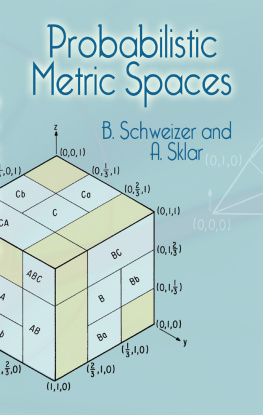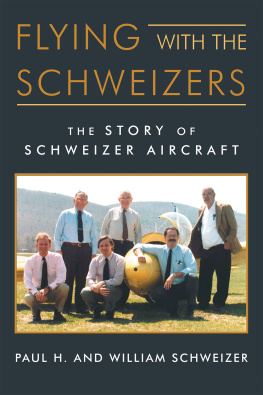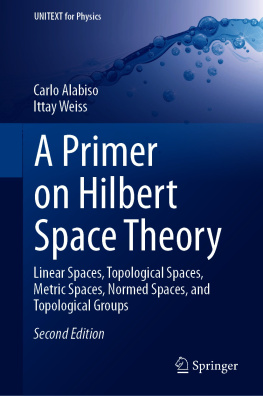B. Schweizer - Probabilistic Metric Spaces
Here you can read online B. Schweizer - Probabilistic Metric Spaces full text of the book (entire story) in english for free. Download pdf and epub, get meaning, cover and reviews about this ebook. year: 0, publisher: Dover Publ., genre: Science. Description of the work, (preface) as well as reviews are available. Best literature library LitArk.com created for fans of good reading and offers a wide selection of genres:
Romance novel
Science fiction
Adventure
Detective
Science
History
Home and family
Prose
Art
Politics
Computer
Non-fiction
Religion
Business
Children
Humor
Choose a favorite category and find really read worthwhile books. Enjoy immersion in the world of imagination, feel the emotions of the characters or learn something new for yourself, make an fascinating discovery.
- Book:Probabilistic Metric Spaces
- Author:
- Publisher:Dover Publ.
- Genre:
- Year:0
- Rating:3 / 5
- Favourites:Add to favourites
- Your mark:
- 60
- 1
- 2
- 3
- 4
- 5
Probabilistic Metric Spaces: summary, description and annotation
We offer to read an annotation, description, summary or preface (depends on what the author of the book "Probabilistic Metric Spaces" wrote himself). If you haven't found the necessary information about the book — write in the comments, we will try to find it.
Probabilistic Metric Spaces — read online for free the complete book (whole text) full work
Below is the text of the book, divided by pages. System saving the place of the last page read, allows you to conveniently read the book "Probabilistic Metric Spaces" online for free, without having to search again every time where you left off. Put a bookmark, and you can go to the page where you finished reading at any time.
Font size:
Interval:
Bookmark:
PROBABILISTIC
METRIC SPACES
B. SCHWEIZER
Professor Emeritus of Mathematics
University of Massachusetts
A. SKLAR
Professor Emeritus of Mathematics
Illinois Institute of Technology
DOVER PUBLICATIONS, INC.
Mineola, New York
PROBABILISTIC
METRIC SPACES
Copyright
Copyright 1983 by Elsevier Science Publishing Co., Inc.
Copyright 2005 by B. Schweizer and A. Sklar
All rights reserved.
Bibliographical Note
This Dover edition, first published in 2005, is an unabridged republication of the work first published by Elsevier Science Publishing Co., Inc., in 1983. A new Preface to the Dover edition, list of Errata, Notes, and Supplementary References have been added.
International Standard Book Number: 978-0-486-14375-0
Manufactured in the United States by Courier Corporation
44514302
www.doverpublications.com
Preface to the Dover Edition
The republication of our book has given us the opportunity to provide, not only the customary list of errata (fortunately, nearly all minor), but also an extensive set of notes and a supplementary bibliography which together follow the unaltered original text and serve to update it.
The scope of the notes (particularly, those referring to ) and the length of the supplementary bibliography (which is by no means complete) testify to the remarkable growth of interest in and applications of several parts of the subject. Many persons have contributed to this growth: Besides the persons named in the original preface and whose work is still continuing, we thank the following ones, with whom we have personally interacted: J. Aczl, F. Balibrea, G. DallAglio, W. F. Darsow, E. Diday, G.-L. Forti, C. Genest, Tie-Xin Guo, U. Hhle, M. F. Janowitz, E. P. Klement, G. M. Krause, B. Lafuerza-Guilln, R. B. Nelsen, L. Paganoni, J. J. Quesada-Molina, T. Riedel, J. A. Rodriguez-Lallena, C. Sempi, J. Smital, M. D. Taylor, and E. Trillas.
The original edition of our book has been long out of print, yet has been the subject of increasing demand. We therefore owe special thanks to Dover Publications, and to its editor John Grafton in particular, for making it again available in an expanded edition. And for her professional, insightful, and cheerful assistance in preparing this expanded edition, we thank Kathy Richards.
Sadly, since 1983, we have lost several friends and colleagues who had participated in this enterprise. So we pay tribute here to the memory of our mentor Karl Menger, and also to the memory of Pietro Benvenuti, Alan T. Bharucha-Reid, Violet Fiatte, Bruno Forte, Joseph Kamp de Friet, Marek Kuczma, and Gyrgy Targonski.
Preface
The story of this book begins in 1951 when the first author was reading the book Albert Einstein, Philosopher-Scientist. There, in a paper by Karl Menger entitled Modem Geometry and the Theory of Relativity, he came across the following passage:
Poincar, in several of his famous essays on the philosophy of science, characterized the difference between mathematics and physics as follows: In mathematics, if the quantity A is equal to the quantity B, and B is equal to C, then A is equal to C; that is, in modern terminology: mathematical equality is a transitive relation. But in the observable physical continuum equal means indistinguishable; and in this continuum, if A is equal to B, and B is equal to C, it by no means follows that A is equal to C. In the terminology of the psychologists Weber and Fechner, A may lie within the threshold of B, and B within the threshold of C, even though A does not lie within the threshold of C. The raw result of experience, says Poincar, may be expressed by the relation

which may be regarded as the formula for the physical continuum. That is to say, physical equality is not a transitive relation.
Is this reasoning cogent? It is indeed easy to devise experiments which prove that the question whether two physical quantities are distinguishable cannot always be answered by a simple Yes or No. The same observer may regard the same two objects sometimes as identical and sometimes as distinguishable. A blindfolded man may consider the simultaneous irritation of the same two spots on his skin sometimes as one, and sometimes as two tactile sensations. Of two constant lights, he may regard the first sometimes as weaker than, sometimes as equal to, and sometimes as stronger than the second. All that can be done in this situation is to count the percentage number of instances in which he makes any one of these two or three observations. In the observation of physical continua, situations like the one just described seem to be the rule rather than the exception.
Instead of distinguishing between a transitive mathematical and an intransitive physical relation of equality, it thus seems much more hopeful to retain the transitive relation in mathematics and to introduce for the distinction of physical and physiological quantities a probability, that is, a number lying between 0 and 1.
Elaboration of this idea leads to the concept of a space in which a distribution function rather than a definite number is associated with every pair of elements. The number associated with two points of a metric space is called the distance between the two points. The distribution function associated with two elements of a statistical metric space might be said to give, for every x, the probability that the distance between the two points in question does not exceed x. Such a statistical generalization of metric spaces appears to be well adapted for the investigation of physical quantities and physiological thresholds. The idealization of the local behavior of rods and boards, implied by this statistical approach, differs radically from that of Euclid. In spite of this fact, or perhaps just because of it, the statistical approach may provide a useful means for geometrizing the physics of the microcosm.
Reading this passage crystallized this authors own thoughts on this topic and, in short order, led to his coming to the Illinois Institute of Technology to pursue his graduate studies under Mengers direction. The second author joined the faculty of I.I.T. in 1956, and soon thereafter our collaboration on probabilistic metric spaces began. In the intervening years the subject has grown into a coherent whole which is the theme of this book.
In our development we follow Menger and work directly with probability distribution functions, rather than with random variables. This means that we take seriously the fact that the outcome of any series of measurements of the values of a nondeterministic quantity is a distribution function; and that a probability space, although an exceedingly useful mathematical construct, is in fact and in principle unobservable. This point of view gives our subject a distinct nonclassical flavor. It has also forced us to develop a considerable body of new mathematical machinery. Our book thus divides naturally into two major parts. After the introductory to the development of this machinery. Our presentation here is complete in the sense that all the needed concepts are defined, all the needed results are stated, and virtually all the proofs not available in the literature are given.
The study of probabilistic metric spaces proper begins with to several related structures, such as probabilistic normed and inner-product spaces. Throughout, we are primarily interested in developing those aspects of the theory that differ from the theory of ordinary metric spaces, and not simply in transferring known metric space results to a more general setting.
Next pageFont size:
Interval:
Bookmark:
Similar books «Probabilistic Metric Spaces»
Look at similar books to Probabilistic Metric Spaces. We have selected literature similar in name and meaning in the hope of providing readers with more options to find new, interesting, not yet read works.
Discussion, reviews of the book Probabilistic Metric Spaces and just readers' own opinions. Leave your comments, write what you think about the work, its meaning or the main characters. Specify what exactly you liked and what you didn't like, and why you think so.












